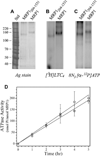Structure of a human multidrug transporter in an inward-facing conformation
- PMID: 20109555
- PMCID: PMC3232029
- DOI: 10.1016/j.jsb.2010.01.011
Structure of a human multidrug transporter in an inward-facing conformation
Abstract
Multidrug resistance protein 1 (ABCC1) is a member of the 'C' class of ATP-binding cassette transporters, which can give rise to resistance to chemotherapy via drug export from cells. It also acts as a leukotriene C4 transporter, and hence has a role in adaptive immune response. Most C-class members have an additional NH(2)-terminal transmembrane domain versus other ATP-binding cassette transporters, but little is known about the structure and role of this domain. Using electron cryomicroscopy of 2D crystals, data at 1/6per A(-1) resolution was generated for the full-length ABCC1 protein in the absence of ATP. Analysis using homologous structures from bacteria and mammals allowed the core transmembrane domains to be localised in the map. These display an inward-facing conformation and there is a noteworthy separation of the cytoplasmic nucleotide-binding domains. Examination of non-core features in the map suggests that the additional NH(2)-terminal domain has extensive contacts on one side of both core domains, and mirrors their inward-facing configuration in the absence of nucleotide.
Figures





Similar articles
-
Structure of Ycf1p reveals the transmembrane domain TMD0 and the regulatory region of ABCC transporters.Proc Natl Acad Sci U S A. 2021 May 25;118(21):e2025853118. doi: 10.1073/pnas.2025853118. Proc Natl Acad Sci U S A. 2021. PMID: 34021087 Free PMC article.
-
Multidrug resistance ABC transporters.FEBS Lett. 2003 Nov 27;555(1):102-5. doi: 10.1016/s0014-5793(03)01085-8. FEBS Lett. 2003. PMID: 14630327 Review.
-
Conserved allosteric hot spots in the transmembrane domains of cystic fibrosis transmembrane conductance regulator (CFTR) channels and multidrug resistance protein (MRP) pumps.J Biol Chem. 2014 Jul 18;289(29):19942-57. doi: 10.1074/jbc.M114.562116. Epub 2014 May 29. J Biol Chem. 2014. PMID: 24876383 Free PMC article.
-
Structural Basis of Substrate Recognition by the Multidrug Resistance Protein MRP1.Cell. 2017 Mar 9;168(6):1075-1085.e9. doi: 10.1016/j.cell.2017.01.041. Epub 2017 Feb 23. Cell. 2017. PMID: 28238471
-
Structure and mechanism of ABC transporter proteins.Curr Opin Struct Biol. 2007 Aug;17(4):412-8. doi: 10.1016/j.sbi.2007.07.003. Epub 2007 Aug 27. Curr Opin Struct Biol. 2007. PMID: 17723295 Review.
Cited by
-
Multidrug resistance protein 1 (MRP1, ABCC1), a "multitasking" ATP-binding cassette (ABC) transporter.J Biol Chem. 2014 Nov 7;289(45):30880-8. doi: 10.1074/jbc.R114.609248. Epub 2014 Oct 3. J Biol Chem. 2014. PMID: 25281745 Free PMC article. Review.
-
The Structure and Mechanism of Drug Transporters.Methods Mol Biol. 2021;2342:193-234. doi: 10.1007/978-1-0716-1554-6_8. Methods Mol Biol. 2021. PMID: 34272696 Free PMC article.
-
Functional Expression of Multidrug Resistance Protein 4 MRP4/ABCC4.SLAS Discov. 2019 Dec;24(10):1000-1008. doi: 10.1177/2472555219867070. Epub 2019 Aug 5. SLAS Discov. 2019. PMID: 31381460 Free PMC article.
-
The cystic fibrosis transmembrane conductance regulator (CFTR): three-dimensional structure and localization of a channel gate.J Biol Chem. 2011 Dec 9;286(49):42647-42654. doi: 10.1074/jbc.M111.292268. Epub 2011 Sep 19. J Biol Chem. 2011. PMID: 21931164 Free PMC article.
-
Transverse and tangential orientation of predicted transmembrane fragments 4 and 10 from the human multidrug resistance protein (hMRP1/ABCC1) in membrane mimics.Eur Biophys J. 2011 Sep;40(9):1043-60. doi: 10.1007/s00249-011-0721-4. Epub 2011 Jun 24. Eur Biophys J. 2011. PMID: 21701864
References
-
- Auer M, Scarborough GA, Kuhlbrandt W. Three-dimensional map of the plasma membrane H+-ATPase in the open conformation. Nature. 1998;392:840–843. - PubMed
-
- Auer M, Scarborough GA, Kuhlbrandt W. Surface crystallisation of the plasma membrane H+-ATPase on a carbon support film for electron crystallography. J. Mol. Biol. 1999;287:961–968. - PubMed
-
- Awayn NH, Rosenberg MF, Kamis AB, Aleksandrov LA, Riordan JR, Ford RC. Crystallographic and single-particle analyses of native and nucleotide-bound forms of the cystic fibrosis transmembrane conductance regulator (CFTR) protein. Biochem. Soc. Trans. 2005;33:996–999. - PubMed
-
- Bakos E, Hegedus T, Hollo Z, Welker E, Tusnady GE, Zaman GJR, Flens MJ, Varadi A, Sarkadi B. Membrane topology and glycosylation of the human multidrug resistance-associated protein. J. Biol. Chem. 1996;271:12322–12326. - PubMed
Publication types
MeSH terms
Substances
Grants and funding
LinkOut - more resources
Full Text Sources
Research Materials
Miscellaneous

